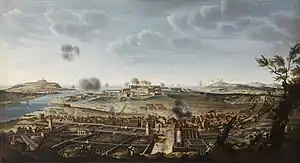Siege of Fort St Philip (1756)
The Siege of Fort St Philip (commonly known in Britain as the Fall of Minorca or Siege of Minorca) took place in 1756 during the Seven Years' War.
| Siege of Fort St. Philip | |||||||
|---|---|---|---|---|---|---|---|
| Part of the Seven Years' War | |||||||
 Attack and capture of Fort St. Philip on the island of Menorca, 29 June 1756, after the naval battle. | |||||||
| |||||||
| Belligerents | |||||||
|
|
| ||||||
| Commanders and leaders | |||||||
|
|
| ||||||
| Strength | |||||||
| 2,860 [1] | 15,000 | ||||||
| Casualties and losses | |||||||
| 400 dead or wounded |
800 dead 2,000–3,000 wounded | ||||||
Order of Battle
British Army
Land forces which formed part of the garrison included:[2]
- 4th (The King's Own) Regiment of Foot
- 7th Regiment of Foot (Royal Fusiliers)
- 23rd Regiment of Foot (Royal Welch Fusiliers)
- 24th Regiment of Foot
- 34th Regiment of Foot
French Army
The French invasion force consisted of:[3][4][5][6][7]
- 1er Bataillon du Régiment de Cambis (2nd Btn later joined, originally garrisoned in Monaco)
- 1er & 2e Bataillons du Régiment de Vermandois
- 1er & 2e Bataillons du Régiment de Rohan Rochefort
- 1er & 2e Bataillons du Régiment de Médoc
- 1er & 2e Bataillons du Régiment Royal
- 1er & 2e Bataillons du Régiment de Bretagne
- 1er & 2e Bataillons du Régiment de Haynault
- 1er & 2e Bataillons du Régiment de Talaru
- 1er & 2e Bataillons du Régiment de Briqueville
- 1er & 2e Bataillons du Régiment de La Marine
- 1er Bataillon du Régiment de La Marche
- 1er Bataillon du Régiment de Briqueville
- 1er Bataillon du Régiment de Royal Italien
- 1er Bataillon du Régiment de Soissonnais
- 1er Bataillon du Royal–Artillerie (Chabrié)
- x1 Compagnie du Miners
- x1 Compagnie du Workers
Arriving later as reinforcements:
- 1er & 2e Bataillons du Régiment de Traisnel (arriving on 15 May)
- 1er & 2e Bataillons du Régiment de Nice (arriving on 21 May)
Siege

A French force under the command of the Duke de Richelieu landed on the island and besieged the British garrison at St. Philip's Castle, forcing them to surrender after a lengthy siege. A British relief force under Admiral John Byng sailed with the purpose of saving the island, but after the naval Battle of Minorca, Byng withdrew to Gibraltar, and the resistance of the garrison finally collapsed. Byng was later blamed for the loss of Menorca (historically called "Minorca" by the British), and executed by firing squad. One involved in the British navy in this operation was Arthur Phillip, later to be first Governor of New South Wales.
The garrison's resistance had been considered lengthy and honourable enough for them to be allowed to march out carrying their arms and be shipped back home to Britain, a common convention at the time. Blakeney was absolved of any blame for the loss of the island, and was later awarded an Irish peerage in recognition of his defence of Fort St Phillip.[8]
Aftermath
Hyacinthe Gaëtan de Lannion was appointed the first French Governor of Menorca. A British naval squadron led by Sir Edward Hawke sent out to replace Byng, arrived off Menorca shortly after the surrender. As Hawke did not have enough troops on board to land and mount a siege to retake the island he departed, cruising in the waters off Marseilles for three months before sailing home. He was later criticised for failing to mount a blockade of the island, which might have forced it to surrender through starvation.[9]
The French held on to Menorca for the remainder of the war, the only British territory they were to occupy, and at the Treaty of Paris it was returned to Britain in exchange for Guadeloupe. Menorca was captured from the British again in 1781 during the Anglo-Spanish War, after which it was ceded to Spain.
References
- History, Debates & Proceedings of Parliament 1743-1774; Volume III. Debrett. 1792. p. 295.
- "The Seven Years' War in Europe, 1756-1763". 2007-10-20. Archived from the original on 2007-10-20. Retrieved 2020-08-24.
- Louis Susane, Historie de La Cavalerie Fraçais, Volumes I–III.
- Louis Susane, Historie de L'Ancienne Infanterie Français, Volumes I–VIII.
- Louis Susane, Historie de L'Artillerie Français.
- "1756 - Siege of Fort St. Philip - Project Seven Years War". www.kronoskaf.com. Retrieved 2020-08-24.
- "1756 - French expedition against Minorca - Project Seven Years War". www.kronoskaf.com. Retrieved 2020-08-24.
- "No. 9642". The London Gazette. 7 December 1756. p. 1.
- Pope p.193-94
Bibliography
- Anderson, Fred. Crucible of War: The Seven Years' War and the Fate of Empire in British North America, 1754-1766. Faber and Faber, 2000.
- Browning, Reed. The Duke of Newcastle. Yale University Press, 1975.
- Longmate, Norman. Island Fortress: The Defence of Great Britain, 1603-1945. Harper Collins, 1993
- McLynn, Frank. 1759: The Year Britain Became Master of the World. Pimlico, 2005.
- Pope, Dudley. At 12 Mr Byng was shot". London, 2002 (1962).
- Rodger NAM. Command of the Ocean: A Naval History of Britain, 1649-1815. Penguin Books, 2006.
- Simms, Brendan. Three Victories and a Defeat: The Rise and Fall of the First British Empire. Penguin Books, 2008.